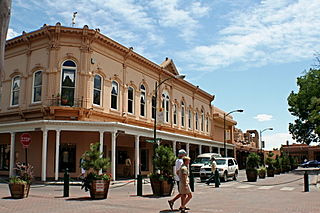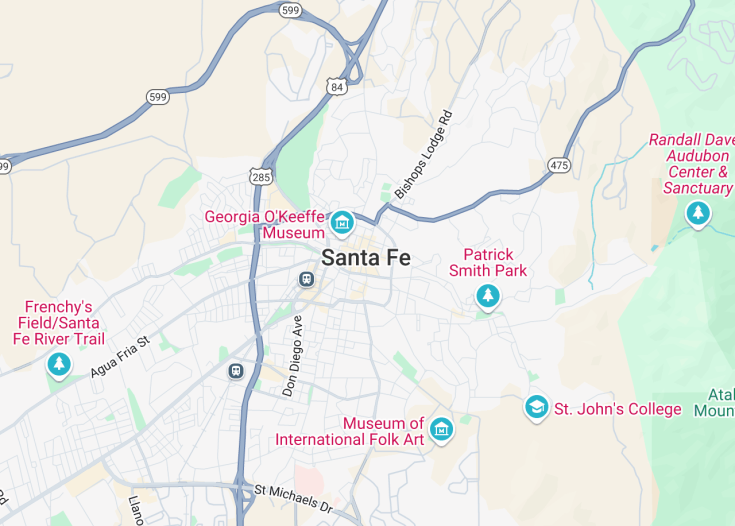Santa Fe, the capital of New Mexico, is renowned for its Pueblo-style architecture and as a vibrant arts hub. The historic heart of the city, The Plaza, is surrounded by landmarks like the Palace of the Governors, now home to the New Mexico History Museum. The city’s unique cuisine, a fusion of Spanish and Native American flavors, complements its artistic flair. Santa Fe’s surrounding landscape offers picturesque hills and trails, making it a prime destination for outdoor enthusiasts and culture seekers alike.
Be sure to explore the vibrant arts scene, particularly the galleries on Canyon Road, which showcase an extensive array of contemporary and traditional art.
Plan your visit around the Santa Fe Indian Market or the International Folk Art Market to experience world-renowned indigenous art and culture.
Top things to do & see in Santa Fe
Select the following sights and activities to discover best tickets and tours available in Santa Fe.
Santa Fe: The Heart of Southwestern Culture
| Country | New Mexico (USA) |
| Time in Santa Fe | GMT-7 |
| Language spoken | English |
| Population | 87,505 (according to the latest census data) |
| Currency | United States Dollar (USD $) |
| Airports |
|
Known for its Pueblo-style architecture and a vibrant arts scene, Santa Fe, the capital of New Mexico, boasts a unique charm that blends its rich history with modernity. Nestled at 7,000 feet above sea level, it is one of the highest state capitals in the United States. The city’s history dates back to around 1050 AD, when it was originally occupied by a number of Pueblo Indian villages. European influences arrived in the 16th century with Spanish explorers, marking the beginning of over 400 years of history that can be felt through its cobblestone streets, historic buildings, and ancient sites.
Santa Fe is a haven for art lovers, hosting the world-renowned Santa Fe Opera and numerous art galleries that lie along Canyon Road. Beyond the arts, it is a city deeply connected to its natural surroundings, showcased in destinations like the Santa Fe National Forest and the nearby Sangre de Cristo Mountains. It serves not only as a cultural hub but also as a gateway to outdoor adventures.
The city’s culinary scene is as rich as its culture, with New Mexican cuisine offering a unique blend of Native American and Spanish flavors, highlighted by its famous green and red chile, which is celebrated yearly during the Santa Fe Wine and Chile Fiesta. Santa Fe’s commitment to preserving its multicultural heritage and environment is evident in its eclectic museums, festivals, and community-focused events, making it a captivating city for residents and visitors alike.
Where is Santa Fe?
Santa Fe is centrally located in the heart of Northern New Mexico, surrounded by miles of stunning natural landscapes.
Distances:
| Route | Distance by car | Time by car |
|---|---|---|
| Albuquerque to Santa Fe | 64 miles | 1 hour |
| Taos to Santa Fe | 70 miles | 1 hour 25 minutes |
| Las Vegas (NM) to Santa Fe | 66 miles | 1 hour 10 minutes |
What is Santa Fe famous for?
Santa Fe is renowned for its Pueblo-style architecture and its status as a hub for arts and culture in the Southwest, housing an extensive number of art galleries, boutiques, and a vibrant culinary scene.
History
Pre-Columbian Period
The region around Santa Fe, New Mexico, has a rich history predating European colonization. Native American tribes, particularly the Puebloan peoples, inhabited the area for thousands of years. They developed complex societies known for their architectural, artistic, and agricultural achievements.
1598-1821: Spanish Colonial Period
Santa Fe was founded around 1610 by Spanish colonists, making it one of the oldest cities in the United States. Originally established as the capital of the Spanish province of Nuevo México, Santa Fe served as a major trade and administrative center. The Spanish influence remains evident in the city’s architecture and cultural traditions.
1821-1848: Mexican Rule
Following Mexico’s independence from Spain in 1821, Santa Fe became part of Mexico. During this period, the Santa Fe Trail was established, enhancing trade between the United States and Mexico and playing a crucial role in the development of the American West.
1848-Present: American Period
After the U.S. annexation of New Mexico during the Mexican-American War, Santa Fe continued as the territorial capital. Throughout the 20th and into the 21st century, Santa Fe has become known globally as a center for arts and culture, drawing artists, writers, and tourists alike. Its unique blend of Native American, Hispanic, and Anglo-American heritages makes it a vibrant historical hub.
Visit Santa Fe
What to see and do in Santa Fe, New Mexico (USA).
Santa Fe, New Mexico, is a treasure trove of historical sites, cultural experiences, and artistic expressions. Among the top attractions are the historic Plaza, the Palace of the Governors, and the Santa Fe Opera House. Art lovers can explore the Georgia O’Keeffe Museum and numerous galleries on Canyon Road. Outdoor enthusiasts will enjoy the nearby hiking trails at Atalaya Mountain or skiing in the Sangre de Cristo Mountains.
- Historic Plaza
- Palace of the Governors
- Santa Fe Opera House
- Georgia O’Keeffe Museum
- Canyon Road galleries
- Atalaya Mountain trails
- Sangre de Cristo Mountains for skiing.
Events in Santa Fe.
Santa Fe is bustling with events throughout the year. Noteworthy are the Santa Fe Indian Market in August, attracting artists and collectors globally, and the Santa Fe International Folk Art Market in July. The city also hosts the annual Fiestas de Santa Fe, a traditional event commemorating its Spanish roots, held in September.
Best time to visit Santa Fe
The best time to visit Santa Fe is during the spring and fall, particularly from May to June and September to October. These months offer pleasant weather and coincide with many of the city’s vibrant cultural events and festivals.
Is Santa Fe worth visiting?
Indeed, Santa Fe is well worth a visit. With its rich tapestry of history, coupled with a vibrant arts scene and breathtaking natural surroundings, Santa Fe offers a unique cultural experience that blends Native American, Hispanic, and Anglo influences. Whether you’re looking to explore historical sites, enjoy world-class art, or revel in the natural beauty, Santa Fe provides an enriching and unforgettable experience.









